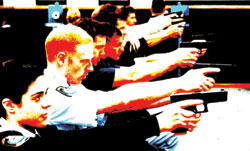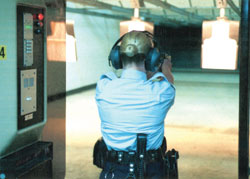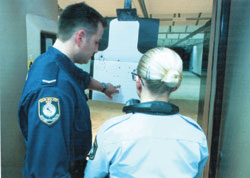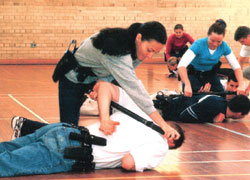Australia's Police services - firearms, training and philosophy
by Mike Wellington
Australian Shooter February 2004
October 14, 2003, two people were killed in their family home in Greenacre, Sydney when up to a hundred shots were fired from the roadside by gunmen in what the media termed a ‘drive-by shooting’. Although police were not directly involved at the time of the deadly assault, inevitably the time will come when investigating officers must confront the offenders - who may or may not resist arrest and resort to the use of firearms.
 As is often the case, one or more of the killers could be encountered during a routine warrant call by radio following a random licence or breath check by officers unprepared for a sudden and possibly fatal shootout. Cocooned in the security of their own lives, far too few members of the public consider the very real danger faced by the police in a confrontation such as this.
As is often the case, one or more of the killers could be encountered during a routine warrant call by radio following a random licence or breath check by officers unprepared for a sudden and possibly fatal shootout. Cocooned in the security of their own lives, far too few members of the public consider the very real danger faced by the police in a confrontation such as this.
There has been considerable media debate during the past decade over whether Australia’s police should be armed, or whether our police - like the British bobby - should be equipped with nothing more lethal than the traditional truncheon (baton). The recent Greenacre shooting and similar shootings throughout the years must surely demonstrate that Australian police need to be well-trained in the use of modern firearms and equipped with the best firearms our tax dollars can provide.
Sworn to uphold the law and to protect the public, the Australian police officer is aware that sooner or later they may be in a position to decide whether to shoot an offender in defence of their own life, the life of a colleague or to protect a member of the public - or not to shoot.
Police do not often have the luxury of time to make anything more than the instinctive, hopefully correct, choice of action. The ability to arrive at the right decision is the end product of a training regimen enforced by Australia’s state police academies which is second to none.
A police officer who has fired his or her weapon in public is required to submit a comprehensive report to justify the shot fired, and the incident is rigorously investigated by the officer’s bureau of internal investigation. Secondly, in the event that a person is wounded or killed, the officer must prove during a coronial inquest, that he/she acted with humanity, caution and prudence and was compelled by necessity to use his (or her) firearm.
How does a police officer’s training and the range of weapons at his/her disposal equip the average Australian police officer to deal with such a potentially fatal (and career threatening) situation?
While the Australian police force use a variety of firearms - including bolt action and self-loading rifles, shotguns and even sub-machine-guns - it is the pistol the public normally associates with the policeman. Worn on the police officer’s duty belt in either a leather or cordura holster, the firearm adopted for use by most state police forces is the .38 or .357 Smith & Wesson revolver or increasingly the Glock self-loading pistol (SLP).
 Patrol officers of the South Australian Police (SAPOL) currently use the Model 19 Smith & Wesson .38 with a 4" barrel, or the more easily concealable Model 66 S & W with the 2½" barrel. As in all police forces around the country, those accepted for induction into SAPOL undergo comprehensive firearms instruction during the Constable Development Program.
Patrol officers of the South Australian Police (SAPOL) currently use the Model 19 Smith & Wesson .38 with a 4" barrel, or the more easily concealable Model 66 S & W with the 2½" barrel. As in all police forces around the country, those accepted for induction into SAPOL undergo comprehensive firearms instruction during the Constable Development Program.
Together with considerable time spent in the study of police regulations and statutory restrictions on the use of firearms by police, recruits must become proficient in the elements of firearm safety, ballistics, and ‘dry’ and live firing. The live firing phase incorporates shooting from standing, kneeling and prone positions at varying distances from the target.
Firearm training in the police services surveyed is thorough and conducted by expert instructional staff. Firearm and tactical defence instructors are cross-posted from their normal policing duties to specialised departments. The same instructional staff are usually also responsible for training in the use of manual restraints (handcuffs), ‘open hand’ defensive techniques, and the extendable baton.
Basic instruction and continuation training within the South Australia Police (SAPOL) is the responsibility of the Operational Safety Training Unit (OSTU). Such training is conducted at the Fort Largs Police Academy where the facilities include a state-of-the-art indoor range with turning/moving target systems equal to any in use by the Defence Forces. All operation SAPOL officers must requalify annually with the issue firearm.
With considerable time spent in the study of police regulations and statutory restrictions pertaining to the use of firearms by police, police recruits must become proficient in the elements of firearm safety, dry and live firing, and some knowledge of ballistics. The live firing phase incorporates shooting from standing, kneeling and prone positions at varying distances from the target. Recruits must achieve a 100 per cent pass in weapon handling and marksmanship. Failure would result in remedial training until the satisfactory result is achieved - or even the student’s return to civilian life should this prove to be non-achievable.
I asked several police services I contacted whether prior training or experience with firearms was an advantage for the police recruit. As a retired soldier I suppose I was hoping to hear that military experience would be viewed as an asset. This is not the case.
Senior Sergeant Dave Whitnell, OIC the Operational Safety and Tactics Training Unit of the West Australia Police Service, explained many police recruits entered the service without any previous firearms knowledge. This did not affect the achievement of firearms proficiency and their necessary weapons qualification. “If anything,” he wrote, “We are finding these persons easier to train than those that may have picked up unsound tactical habits though previous exposure to firearms.”
Police services require their officers to be firearms proficient throughout their service. The Northern Territory Police policy is to conduct regular refresher training on all firearms in use by their officers - including handguns, shotguns and rifles. Weapons in use by the NT Police at the time of writing include the Glock model 22 .40S&W pistol (general duties police); the Glock model 27 .40S&W pistol (CIB); the Remington model 870 pump action shotgun; the Remington model 700 (.308) bolt action rifle; the BRNO model 601 (.308) bolt action rifle; and the BRNO model 2 (.22lr) bolt action rifle.
 While the weapons and training regimes of Tactical Operations Groups are outside the scope of this article, the NT Police have also qualified members of specialist groups to use the AR15 semi-auto rifle. In 1992 the NT Police made the decision to change from the traditional police pistol, the .38 and .357 S&W revolvers, to the Glock self-loading pistol (SLP), bringing them into line with other police forces, both in Australia and overseas.
While the weapons and training regimes of Tactical Operations Groups are outside the scope of this article, the NT Police have also qualified members of specialist groups to use the AR15 semi-auto rifle. In 1992 the NT Police made the decision to change from the traditional police pistol, the .38 and .357 S&W revolvers, to the Glock self-loading pistol (SLP), bringing them into line with other police forces, both in Australia and overseas.
Assistant Commissioner Mark McAdie of the NT Police explained that continuation training for his officers takes place at least once per year, although many individual officers like to train and requalify more often than is officially required. A personal enthusiasm for marksmanship with their firearms was found to be a common trait throughout most Australian police services.
Like the Territorians, the West Australia Police Service (WAPS) has recently adopted the Glock where Models 22 and 23 in .40 cal are issued for general duty and CIB members respectively. Additionally Remington 870 pump-action shotguns and Sako .223 bolt-action rifles are available for use by police units as required. Once again, the WA Police tactical unit has access to a variety of additional weapons.
Initial instructor and armourer training and advice in the replacement weapon was provided by experts from Glock (HK) Ltd. Ongoing liaison with other Australian and some international law-enforcement bodies has ensured that the West Australian Police have developed a high degree of tactical proficiency service-wide. This skill at arms and general tactical proficiency is maintained by means of a biannual one-day ‘critical skills’ training session. Non-operational police must also attend on a yearly basis. Again, a ‘no-fail’ standard is essential. Officers who fail to reach the required standard of competency with firearms are prohibited from carrying a firearm until the necessary qualification has been attained.
An interesting development accompanying the adoption of the semi-automatic pistol is the ability by prospective police recruits to demonstrate the physical strength required to confidently operate the slide cocking action of the Glock pistol. This test would also be a fair indication of whether the potential police recruit possesses the upper body strength to cope with the rigorous physical training that lies ahead - which includes coaching in baton and grip-release techniques.
Along with firearm training, additional training is required in the use of handcuffs (termed manual restraints), extendable batons, the use of Oleoresin Capsicum (OC) and use and maintenance of bullet resistant body armour (‘bulletproof vests’).
The adoption of the Glock pistol by so many police services, not only in Australia but also in the USA, is based on the proven reliability, simplicity and inbuilt safety features of the Austrian-manufactured weapon. It may be of interest to note that the general service rifle currently in use by the Australian Defence Force, the F88 Steyr, now manufactured under license in at Lithgow NSW, is also an Austrian-designed and developed weapon.
Designed in 1983 by the Austrian engineer, Gaston Glock, the range of pistols produced in his factory are nearly the perfect combination of reliability and accuracy. One of the first things that strike you about this pistol is the absence of an external safety catch.
The Glock ‘safe action’ system incorporates three independent safety measures, all centred on the trigger. The small auxiliary ‘safety blade’ protruding above the trigger surface ensures the weapon cannot be fired unless the operator deliberately pulls through on the trigger.
 Unlike the Berettas, Brownings and Colts of the pistol genre, the Glock has no external hammer. Cartridge detonation is by means of a striker housed in the breech block. The positive nature of the trigger ‘safety’ means the pistol will not discharge should the owner drop the weapon onto a hard surface. Glock GmbH (Gesellschaft mit beschrankter Haftung) maintains with good reason, the combination of the trigger safety; firing pin safety and ‘drop’ safety makes their pistol just about the safest on the market.
Unlike the Berettas, Brownings and Colts of the pistol genre, the Glock has no external hammer. Cartridge detonation is by means of a striker housed in the breech block. The positive nature of the trigger ‘safety’ means the pistol will not discharge should the owner drop the weapon onto a hard surface. Glock GmbH (Gesellschaft mit beschrankter Haftung) maintains with good reason, the combination of the trigger safety; firing pin safety and ‘drop’ safety makes their pistol just about the safest on the market.
In the absence of a de-cocking device, the Glock follows the usual procedure common to the SLP of removing the magazine before ejecting the live cartridge in the breech by operating the slide.
I find it interesting that no Glock I have seen thus far is equipped with a lanyard ring. As a former military policeman in the early 60s I spent many uneasy hours on foot and mobile patrols in such picturesque but potentially deadly colonial hot spots as East Africa, Cyprus and Malaysia, equipped with either a 9mm Stirling SMG or a holstered 9mm Browning pistol secured to my web belt.
Contrary to the approved practice of wearing the upper loop of the lanyard around the neck or shoulder where it was held in place by the epaulette (shoulder strap), we preferred to attach the pistol lanyard with the runner fastened tightly to the belt and close up behind the firearm’s butt with every spare inch of the cord tucked entirely into the holster. This enabled us to retrieve the weapon by physical force in the event it was yanked clear of the holster during the type of fracas which made our working lives both risky and more interesting. Perhaps the sheer quantity of equipment worn about a policeman’s waist in this day and age would make the use of a lanyard impractical. Comments by serving police on this topic would be interesting.
Given the complexity of society in the third millennium and the significance of this to police operations - particularly with regard to human rights - the challenges faced by the modern police officer would appear daunting. With the escalation of global terrorism over the past 30 years and its inevitable impact on our lives here in Australia, we rely heavily on our intelligence services and our state police forces.
Nevertheless some aspects of policing have remained the same for decades - namely the unwelcome but fortunately rare occasion when the police officer is forced to use a firearm in self-defence or to protect the public. As long as the tactical training police officers receive remains at its present high standard and the firearms are the best available, police officers in this country stand a reasonably good chance of coming out of a deadly altercation and may continue to protect the community to the best of his/her ability.
